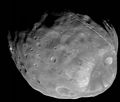Fail:Phobos colour 2008.jpg

Saiz pralihat ini: 636 × 600 piksel. Leraian-leraian lain: 255 × 240 piksel | 509 × 480 piksel | 815 × 768 piksel | 1,086 × 1,024 piksel | 2,172 × 2,048 piksel | 3,500 × 3,300 piksel.
Fail asli (3,500 × 3,300 piksel, saiz fail: 2.72 MB, jenis MIME: image/jpeg)
Sejarah fail
Klik pada tarikh/waktu untuk melihat rupa fail tersebut pada waktu itu.
| Tarikh/Waktu | Gambar kenit | Ukuran | Pengguna | Komen | |
|---|---|---|---|---|---|
| semasa | 03:10, 2 April 2018 |  | 3,500 × 3,300 (2.72 MB) | Kaldari | more margin on right side |
| 04:47, 13 November 2008 |  | 3,374 × 3,300 (2.7 MB) | Fir0002 | == Summary == {{Information |Description=Colour image of Phobos, imaged by the Mars Reconnaisance Orbiter in 2008 |Source=NASA |Date=9 April 2008 |Location=http://www.nasa.gov/mission_pages/MRO/multimedia/pia10368.html |Author=NASA/J |
Penggunaan fail
4 buah laman berikut menggunakan fail ini:
Penggunaan fail sejagat
Fail ini digunakan oleh wiki-wiki lain yang berikut:
- Penggunaan di af.wikipedia.org
- Penggunaan di an.wikipedia.org
- Penggunaan di ar.wikipedia.org
- المريخ
- فوبوس
- قمرا المريخ
- ويكيبيديا:صور مختارة/الفضاء والكون/نظرة إلى الأعلى
- قائمة أجرام المجموعة الشمسية مرتبة حسب الحجم
- بوابة:علم الفلك/صورة مختارة
- بوابة:المريخ/مقالة مختارة/أرشيف
- بوابة:المريخ/مقالة مختارة/2
- قائمة الأقمار الطبيعية
- خط زمني لاكتشاف كواكب المجموعة الشمسية وأقمارها
- ويكيبيديا:ترشيحات الصور المختارة/القمر فوبوس
- ويكيبيديا:صورة اليوم المختارة/أغسطس 2019
- قالب:صورة اليوم المختارة/2019-08-03
- بوابة:علم الفلك/صورة مختارة/73
- معسكر قاعدة المريخ
- ويكيبيديا:صورة اليوم المختارة/يناير 2022
- قالب:صورة اليوم المختارة/2022-01-04
- Penggunaan di ary.wikipedia.org
- Penggunaan di arz.wikipedia.org
- Penggunaan di as.wikipedia.org
- Penggunaan di azb.wikipedia.org
- Penggunaan di az.wikipedia.org
- Penggunaan di be-tarask.wikipedia.org
- Penggunaan di be.wikipedia.org
- Penggunaan di bg.wikipedia.org
- Penggunaan di bh.wikipedia.org
- Penggunaan di bn.wikipedia.org
- Penggunaan di bn.wikibooks.org
- Penggunaan di bs.wikipedia.org
Lihat banyak lagi penggunaan sejagat bagi fail ini.





